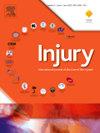Percutaneous plate fixation of displaced proximal humerus fractures: Do minimally invasive techniques improve outcomes and reduce complications?
IF 2.2
3区 医学
Q3 CRITICAL CARE MEDICINE
Injury-International Journal of the Care of the Injured
Pub Date : 2023-12-01
DOI:10.1016/j.injury.2023.111042
引用次数: 0
Abstract
Objective
The aim of this study was to analyze the outcomes and complications of minimally invasive plate osteosynthesis (MIPO) for displaced proximal humerus fractures and elucidate if the percutaneous technique reduces the rate of avascular necrosis (AVN) without jeopardizing fracture reduction.
Material and methods
118 patients with a displaced proximal humerus fracture were treated with a polyaxial locking-plate through a standardized percutaneous approach. 73 % were women and mean age was 63 years (18–89) with an average follow-up of 51 months (12–256). There were 32 two-part fractures (27 %), 57 three-part fractures (48 %) and 24 four-part fractures (25 %). Shoulder function at the last follow-up, including ROM and ability to perform daily living activities, was objectively evaluated with an adjusted Constant Score (CS). Subjective patient satisfaction was rated with an Visual Analogic Scale from 0 to 10 and the degree of residual pain with a Verbal Rating Scale (VRS). Radiographic analysis at the most recent follow-up evaluated the presence of AVN, degree of residual medial calcar displacement, and the cervicodiaphiseal angle.
Results
Forty patients (34 %) had a complication, 25 of them (21 %) requiring further surgery. ROM at the last follow-up was 131° of elevation (40°-180°), 38° of external rotation (SD: 17.7) and internal rotation to L3. Average adjusted Constant Score was 68 (SD: 17.76). Twenty-one patients (18 %) complained of shoulder pain (14 moderate and 7 severe) and seven were not satisfied. Radiographically, 29 patients (25 %) had varus malunion and 17 patients (14 %) showed some degree of AVN. Patients with varus malunion (CS 64.3 versus 69.8, p = 0.16) and AVN (CS 56.9 versus 70.4, p = 0.005) had lower CS. The presence of a varus malunion was directly related to the degree of initial medial calcar displacement (p = 0.001) and deficient calcar reduction at surgery (p = 0.004). AVN was statistically more prevalent when the medial calcar was inadequately reduced (p = 0.01).
Conclusions
MIPO surgery for proximal humerus fractures through an anterolateral approach does not reduce the rate of mechanical complications or AVN compared with standard ORIF techniques. Moreover, percutaneous plating may preclude adequate medial calcar reduction, leading to humeral head malunion and a worse clinical outcome.
经皮钢板固定移位的肱骨近端骨折:微创技术能否提高疗效并减少并发症?
研究目的本研究旨在分析微创钢板骨合成术(MIPO)治疗肱骨近端移位骨折的效果和并发症,并阐明经皮技术是否能在不影响骨折复位的情况下降低血管坏死(AVN)的发生率。73%的患者为女性,平均年龄为63岁(18-89岁),平均随访时间为51个月(12-256个月)。其中两部分骨折 32 例(27%),三部分骨折 57 例(48%),四部分骨折 24 例(25%)。最后一次随访时的肩关节功能,包括活动度和日常生活能力,通过调整后的常量评分(CS)进行客观评估。患者的主观满意度采用视觉类比量表(0-10分)进行评分,残余疼痛程度采用口头评分量表(VRS)进行评分。最近一次随访的放射学分析评估了是否存在AVN、残留的内侧小腿移位程度以及颈二骺角:40名患者(34%)出现并发症,其中25名患者(21%)需要进一步手术治疗。最后一次随访时的活动度为抬高131°(40°-180°),外旋38°(SD:17.7),内旋至L3。调整后的康斯坦茨评分平均为 68(标准差:17.76)。21 名患者(18%)主诉肩部疼痛(14 名中度,7 名重度),7 名患者不满意。从X光片上看,29名患者(25%)出现了肩关节屈曲错位,17名患者(14%)出现了一定程度的AVN。曲度错位(CS 64.3 对 69.8,P = 0.16)和 AVN(CS 56.9 对 70.4,P = 0.005)患者的 CS 值较低。变位错合的出现与最初的小腿内侧移位程度(p = 0.001)和手术时小腿缩窄不足(p = 0.004)直接相关。在统计学上,当内侧小腿腓骨缩窄不足时,AVN的发生率更高(p = 0.01):结论:与标准的ORIF技术相比,通过前外侧入路对肱骨近端骨折进行MIPO手术并不能降低机械并发症或AVN的发生率。此外,经皮钢板可能会妨碍适当的内侧钙化,导致肱骨头骨盆不齐和更差的临床结果。
本文章由计算机程序翻译,如有差异,请以英文原文为准。
求助全文
约1分钟内获得全文
求助全文
来源期刊
CiteScore
4.00
自引率
8.00%
发文量
699
审稿时长
96 days
期刊介绍:
Injury was founded in 1969 and is an international journal dealing with all aspects of trauma care and accident surgery. Our primary aim is to facilitate the exchange of ideas, techniques and information among all members of the trauma team.

 求助内容:
求助内容: 应助结果提醒方式:
应助结果提醒方式:


